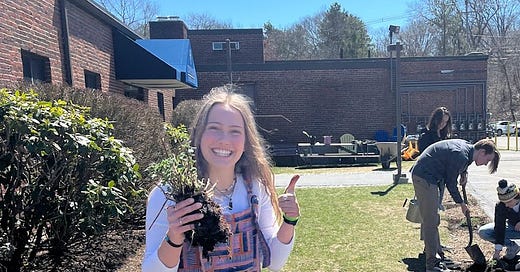Once you start to enjoy gardening, it can be easy to make extravagant plans. Say you fall in love with vegetables one summer, growing a bunch of tomatoes in pots or a small plot. The following November, you may find yourself constantly drifting toward the window, gradually realizing that you’ve begun to draw a planting scheme in your head. Some tulips here, a hazel tree there, forty or fifty catmints along the borders…it’s easy for things to get out of control. Come spring, a crisis is bound to occur when you roll up to the checkout at the garden store and see a bill you’d normally associate with luxury cars.
To garden is to compose in the medium of life: it’s an art form mediated by endless practical affairs, requiring a ton of expertise and a healthy set of well-developed instincts. If you’re new to the practice—as are so many of my students here—the danger of burnout is very real. Even if you can afford to spend the extravagant amount it would take to install a yard’s worth of ornamentals in a single season, the maintenance of all those plants can be exhausting: you might quickly find yourself dreading the very thing that once rejuvenated you. Much better to do what nature does: start small, and grow gradually.
Both at home and here at CCA, slow but steady has been my mantra. And though planting an entire fruit orchard in a single spring might not seem to conform to that philosophy, the lead-up to this explosion was gradual and years long. The need for restraint comes down to this: new plants are expensive and difficult to care for. Luckily, the thrifty gardener has a solution ready to hand: propagation.
Propagation means the multiplication of plants. It’s an art and science as complex and multifaceted as carpentry or animal husbandry. Yet the fact remains that many of the North American gardener’s favorite plants can be multiplied very easily. For example, one April six years ago, a neighbor gave me a small tuft of catmint no bigger than a tennis ball. The roots were still clinging to it. “Stick it in the ground somewhere,” he said. “It will be huge by August.” So it was: fragrant, fun, and long-blooming, the catmint had dominated a whole corner of my garden by the end of summer. The next spring, just as the new leaves began to appear, I pulled it carefully out of the ground, roots and all, chopped it into quarters with a spade and distributed them along the border. Years later, I now have around twenty large plants at home, all derived from this single gift.
Which plants can be propagated this way? The secret is to look for two qualities: first, the plant must be perennial rather than annual. Second, its roots should form mats rather than centering around a single taproot. Columbines, for instance, cannot be divided. But many other plants can: Black-Eyed Susans, Coneflowers, Salvias, Goldenrods, Bee Balms, Chives, Mints, Lemon Balms, and Sedums to name only a few.
Here at Classical Roots, we have frequently “stolen” specimens for our gardens from elsewhere on campus. The Veggie Garden, for instance, is lined with catmints we pilfered from the other side of the school, showing up with a wheelbarrow one day, lifting ten or so of them from a bed, dividing each plant in half, and making off with nearly dozen new plants while leaving their better halves in the ground where we found them. The best part? Division actually helps stimulate new and stronger growth, so we were tending that little garden as well as stealing from it.
The lesson here is that, if you’re hoping to start or expand a garden, either at home or at a school, throwing a bunch of money at the situation might not be the best place to begin. Instead, in early spring, seek out a green-thumbed friend or neighbor who might be willing to divide a plant or two. Better yet, ask if you can come along and learn how to do it. I know of no more generous hobby than gardening—it is a community of shared enthusiasm, shared knowledge, and even shared plants. There’s a certain givenness and giftedness to gardens, a kind of controlled abundance that encourages us to be open-handed. And any garden started with a friendship instead of a trip to the store is headed in the right direction.
Like what you’re reading here? The best way to support the Classical Roots Program is to spread the word. Help us turn school inside out:





